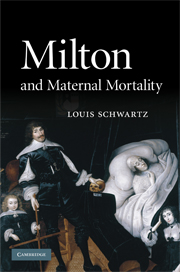Book contents
- Frontmatter
- Contents
- Acknowledgments
- Abbreviations
- Introduction
- PART I BEHIND THE VEIL: CHILDBIRTH AND THE NATURE OF OBSTETRIC ANXIETY IN EARLY MODERN ENGLAND
- PART II “SCARCE-WELL-LIGHTED FLAME”: THE REPRESENTATION OF MATERNAL MORTALITY IN MILTON'S EARLY POETRY
- PART III “CONSCIOUS TERROURS”: THE PROBLEM OF MATERNAL MORTALITY IN MILTON'S LATER POETRY
- 7 The wide wound and the veil: Sonnet 23 and the “birth” of Eve in Paradise Lost
- 8 “Conscious terrours” and “the Promis'd Seed”: seventeenth-century obstetrics and the allegory of Sin and Death in Paradise Lost
- 9 The “womb of waters” and the “abortive gulph”: on the reproductive imagery of Milton's cosmos
- Index
- References
7 - The wide wound and the veil: Sonnet 23 and the “birth” of Eve in Paradise Lost
Published online by Cambridge University Press: 04 December 2009
- Frontmatter
- Contents
- Acknowledgments
- Abbreviations
- Introduction
- PART I BEHIND THE VEIL: CHILDBIRTH AND THE NATURE OF OBSTETRIC ANXIETY IN EARLY MODERN ENGLAND
- PART II “SCARCE-WELL-LIGHTED FLAME”: THE REPRESENTATION OF MATERNAL MORTALITY IN MILTON'S EARLY POETRY
- PART III “CONSCIOUS TERROURS”: THE PROBLEM OF MATERNAL MORTALITY IN MILTON'S LATER POETRY
- 7 The wide wound and the veil: Sonnet 23 and the “birth” of Eve in Paradise Lost
- 8 “Conscious terrours” and “the Promis'd Seed”: seventeenth-century obstetrics and the allegory of Sin and Death in Paradise Lost
- 9 The “womb of waters” and the “abortive gulph”: on the reproductive imagery of Milton's cosmos
- Index
- References
Summary
In the twenty or so years between 1637, when he composed “Lycidas” and published the full-length version of A Mask, and the late 1650s, when he entered the final, relatively intensive periods of work on Paradise Lost, Milton wrote a fair amount of poetry, but it is probably fair to say that it was not his central preoccupation. During these years, he wrote five Latin poems, four Latin epigrams, two sets of psalm paraphrases, a scattering of passages translated for use in several prose tracts, as well as seventeen sonnets, and he seems to have worked intermittently on a longer work about the Fall of Man, at first conceiving of it as a drama and only later reworking it into what became the epic. He was also, however, busy with a number of other things. He traveled on the continent, took on several private pupils for varying lengths of time, and published most of his important prose works (the anti-prelatical and most of the anti-monarchical tracts, as well as Areopagitica, Of Education, and the four divorce tracts). In 1649, he also began working as Secretary of Foreign Tongues for the Council of State, producing over the following ten years a substantial number of official documents of various kinds, mostly diplomatic correspondence and translations. Above all, during these years, Milton married twice and raised a family, in the process confronting the death of first one wife and then the other, as well as the deaths of two of his five children.
- Type
- Chapter
- Information
- Milton and Maternal Mortality , pp. 155 - 210Publisher: Cambridge University PressPrint publication year: 2009



